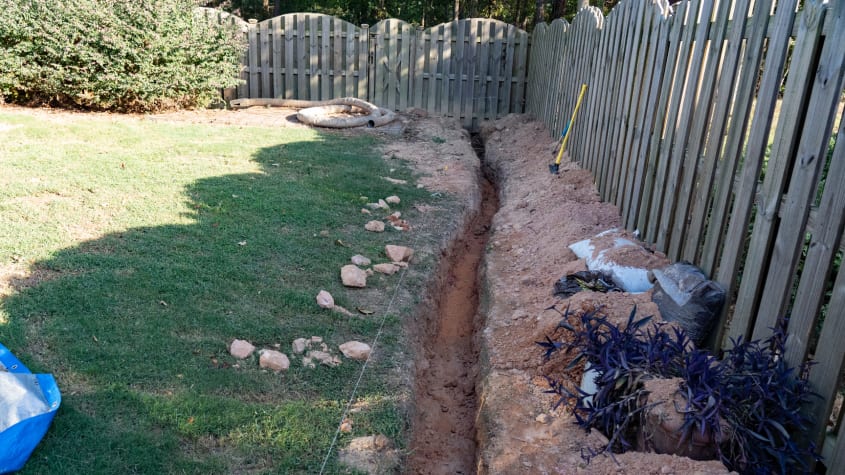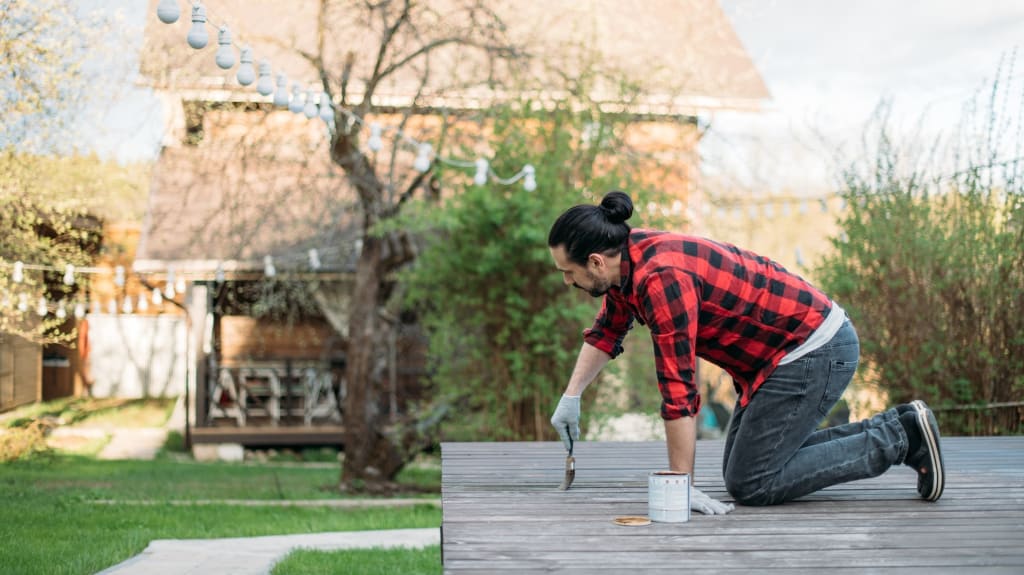Does the sound of rain fill you with anxiety because you know your basement or garden will soon be a soggy mess? Drainage problems in your backyard can lead to water damage and mould in and around your home. Fortunately, you can direct standing water away and prevent expensive repairs with a French drain installation. We’ll show you how!
What is a French drain?

A French drain is a trench dug in the ground of the backyard where pools of water tend to accumulate. The trench contains a perforated pipe that is wrapped in water-permeable fabric and buried below layers of crushed stone. When water collects on the surface, gravity pulls it down through the gravel and into the pipe where it’s carried away.
Heavy rainfall, melting snow, or a leaking hosepipe can lead to large areas of standing water and mud in your backyard. If this water doesn’t drain, it can flow towards your home, causing flooding and severe water damage to your foundation wall and basement. A French drain prevents this from happening by directing the flow of water away from your house.
EspaceProprio Tip The French drain got its name from Henry French, a judge and farmer from Massachusetts. He wrote about the ingenious drainage system in 1859, explaining how it kept excess water away from his crops.
How does a French drain work?

Thanks to gravity, an incline or hill drains water naturally. This is because water always travels downhill and by the easiest route possible. Unfortunately, our backyards tend to be flat, creating the perfect conditions for water to pool if it has nowhere to go. A French drain solves this issue by creating the ideal path for water to follow—down a sloped trench and away from your foundation.
Groundwater seeps through layers of gravel into a trench that slants downwards. Inside the trench, the water enters a hollow pipe (through perforations) and flows towards an exit point where it’s collected in a drainage area (such as a municipal drain, catch basin, or rain garden).
Each component of a French drain system is designed to make it as easy as possible for water to move. Firstly, the pipe is wrapped in a porous fabric that prevents weeds, sand, and other debris from obstructing its holes. Secondly, crushed stone covers the pipe (instead of densely packed soil) because it’s easier for water to move through the larger gaps between stones. Finally, the trench is angled slightly so the water flows away from your house as soon as it enters the pipe.
EspaceProprio Tip If you’re in the market for a new home, check for signs of water damage and accumulation as you view potential properties. This way, you’ll avoid several nasty surprises.
Discover 3 types of French drains

There are different types of French drains, and one may be more suitable, depending on your problem. Whether it’s moisture issues, water infiltration, or structural damage to your house foundation, these are some of the solutions on offer:
1. Shallow French drain
Also known as a curtain drain, this traditional system (a pipe covered in gravel) works well for standing surface water. It’s usually about two feet deep and extends horizontally across your property. It intercepts water and guides it around and away from the problem area.
2. Deep French drain
Installed around your home’s perimeter, this channel stops water before it can get into the basement. It reduces the hydrostatic pressure on the foundation, giving water an alternative route instead of being forced through cracks in the foundation wall. However, it’s best added during the construction of the house as doing so later incurs major costs.
3. Interior French drain
This is the best way to keep your basement dry! The French drain is dug and buried around the perimeter of your basement floor. Any water that seeps through the foundation is collected and sent through a sump pump to the backyard or a storm drain.
Alternative yard drainage solutions

Before you can install a French drain, check the local building codes, zoning laws, and community guidelines. It could be illegal to direct water from your property into local stormwater systems, and if so, you’ll have to choose another drainage system. Here are four alternative drainage solutions you might try:
Sump pump This cylindrical device sits in a pit in the lowest point of your home (typically the basement). After heavy rainfall, the device removes water from the area as well as the soil below, and if the water level reaches a certain point, the sump pump automatically turns on and pumps the water out of the pit and away from the home’s foundation.
Yard drain If there’s a patch in your yard that tends to flood, consider this system which acts exactly like a shower or bath drain. It moves the water through hidden pipes below the ground to an exit point.
Downspout If you’d prefer a cheaper option that doesn’t require digging (and who wouldn’t!), this works well. Downspouts carry water from your roof to the ground; however, you can extend the pipe’s length so the water is carried even further away from your foundation.
Aerating your lawn The most affordable option of them all! Using a sharp tool (such as a garden fork), poke holes in the soil where water usually collects. This keeps your lawn in mint condition because it allows air and nutrients to pass through the soil. However, it’s also great for yard drainage as the standing water can pass through the holes in the ground.
French drain installation: Should you hire a professional?

While it’s possible to install a simple French drain on your own, we recommend hiring a professional for several reasons:
It’s a labour-intensive project. Much of your time will be spent digging, and you may need to hire a trencher to make the job easier and faster.
Choosing the wrong kind of gravel or stone can lead to clogs and drainage issues, which are expensive to fix.
Using the wrong piping could mean the perforations in the pipe aren’t as effective as they need to be.
There could be gas lines and sewage pipes where you’re digging. If you damage one, it will cost plenty to fix (and your neighbours won’t thank you).
Hiring a professional gives you peace of mind. If there are any problems, you can contact the company in question to resolve them.
Failing to calculate the correct angle of the slope could cause the drain to clog or back up with water. A professional who regularly installs these systems will ensure it’s done correctly the first time.
If you decide to hire a professional, RenoAssistance can put you in touch with a dedicated Renovation Advisor and up to three Verified Contractors. It’s an easy process that will save you plenty of time and money.




